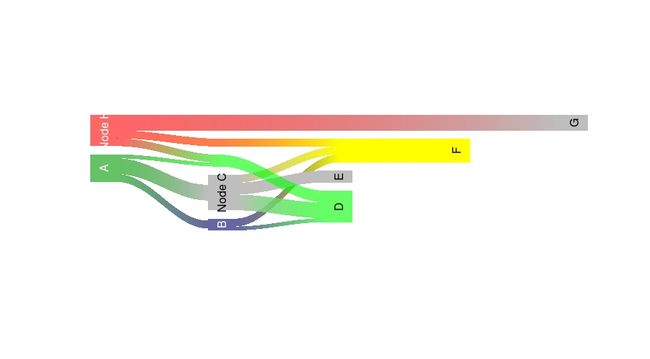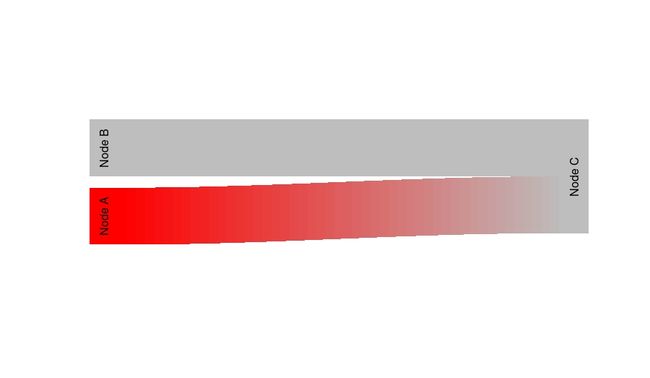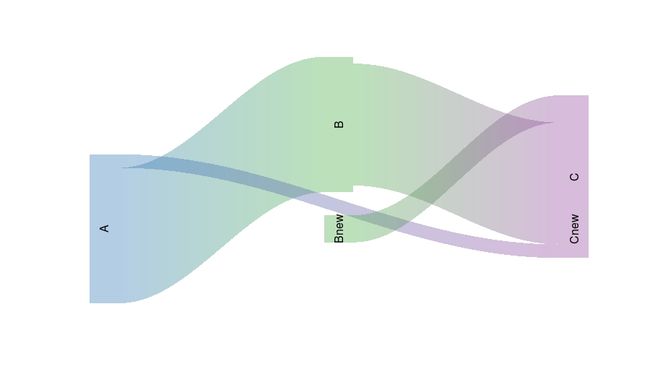桑基图是一种方便说明信息、资源流动和图形,图形中的分、合正如漂流的分叉与汇合,如可用于比较不同簇间关系,可以用来表示各个节点之间转换。
Sankey plots are a type of diagram that is convenient to illustrate how flow of information, resources etc. separates and joins, much like observing how rivers split and merge. For example, they can be used to compare different clusterings.
相关主题:
堆叠柱状图各成分连线画法:突出展示组间物种丰度变化
ggalluvial:冲击图展示组间变化、时间序列和复杂多属性alluvial diagram
network3D: 交互式桑基图
实例2. Sciences封面哈扎人肠道菌群 图1中的D就使用了2个又桑基图。详见3分和30分文章差距在哪里?
在R中可以直接定义点点之间的关系后使用riverplot画桑基图:
安装与载入
install.packages("riverplot")
library(riverplot)
0. 包内部演示数据
plot(riverplot.example())
1. 画一个6级能量流动图/桑基图
# 构造连接节点(边)的数据框,采用runif生成模拟数据
# 实验中每个节点间的连续情况是己知的
# 生成一个组1-5与组2-6对应的值数据框
edges = data.frame(N1 = paste0(rep(LETTERS[1:4], each = 4), rep(1:5, each = 16)),
N2 = paste0(rep(LETTERS[1:4], 4), rep(2:6, each = 16)),
Value = runif(80, min = 2, max = 5) * rep(c(1, 0.8, 0.6, 0.4, 0.3), each = 16),
stringsAsFactors = F)
# 筛选80%的记录,以免每个点都对应到4个点(可选)
edges = edges[sample(c(TRUE, FALSE), nrow(edges), replace = TRUE, prob = c(0.8, 0.2)),]
head(edges)
# 获得非冗余结点nodes
nodes = data.frame(ID = unique(c(edges$N1, edges$N2)), stringsAsFactors = FALSE)
# 添加x: X为组编号,即列位置
nodes$x = as.integer(substr(nodes$ID, 2, 2))
# Y为组类型字符,转换为ASCII编号,减65,即为A/B/C/D转换为0/1/2/3数值,即行位置
nodes$y = as.integer(sapply(substr(nodes$ID, 1, 1), charToRaw)) - 65
# 添加行名
rownames(nodes) = nodes$ID
head(nodes)
# 添加颜色
library(RColorBrewer)
# brewer.pal生成柔合色,后面加调淡颜色
palette = paste0(brewer.pal(4, "Set1"), "60")
# 对每个节点生成相应的列表格式,颜色col,线条类型lty,文字颜色textcol
styles = lapply(nodes$y, function(n) {
list(col = palette[n+1], lty = 0, textcol = "black")
})
names(styles) = nodes$ID
# 将点、单和样式合并为List,构建riverplot对象
rp <- list(nodes = nodes, edges = edges, styles = styles)
# 添加对你属性包括riverplot
class(rp) <- c(class(rp), "riverplot")
# 绘制桑基图,plot_area设置绘图面积,yscale设置Y轴方向缩放
plot(rp, plot_area = 0.95, yscale=0.06)
绘制六个时间点四组间能量流动的桑基图
2. minard图
http://blog.shuoyangdesign.com/?p=564
这个非常著名的图是Charles Minard在1869年所作的拿破仑东征俄国的信息图。Charles Minard是信息图表的之父,他是信息图领域的创始者。这张图描绘的是拿破仑在1812到1813年进攻俄国的情况。它的背景是一个真实的地图,西边是波兰的边境,东边是莫斯科。图上那条主线的宽度代表拿破仑军队的人数,黄色表示进攻路线,黑色表示撤退的路线: 他开始于42万人,在向莫斯科进军的过程中丧失了很多人,到达莫斯科时只剩下10万人,而最后从莫斯科活着返回的只剩下1万人。
Minard图也是桑基图的一种,采用riverplot包也可以绘制。如下:
library( riverplot )
data( minard )
nodes <- minard$nodes
edges <- minard$edges
colnames( nodes ) <- c( "ID", "x", "y" )
colnames( edges ) <- c( "N1", "N2", "Value", "direction" )
# color the edges by troop movement direction
edges$col <- c( "#e5cbaa", "black" )[ factor( edges$direction ) ]
# color edges by their color rather than by gradient between the nodes
edges$edgecol <- "col"
# generate the riverplot object
river <- makeRiver( nodes, edges )
style <- list( edgestyle= "straight", nodestyle= "invisible" )
# plot the generated object
plot( river, lty= 1, default.style= style )
# Add cities
with( minard$cities, points( Longitude, Latitude, pch= 19 ) )
with( minard$cities, text( Longitude, Latitude, Name, adj= c( 0, 0 ) ) )
3. 绘制DNA双链 a DNA strand
plot.new()
par( usr= c( 0, 4, -2.5, 2.5 ) )
w <- 0.4
cols <- c( "blue", "green" )
init <- c( -0.8, -0.5 )
pos <- c( 1, -1 )
step <- 0.5
for( i in rep( rep( c( 1, 2 ), each= 2 ), 5 ) ) {
curveseg( init[i], init[i] + step, pos[1], pos[2], width= w, col= cols[i] )
init[i] <- init[i] + step
pos <- pos * -1
}
4. 绘制简单的分枝图
# 产生三个节点A/B/C
nodes <- c( LETTERS[1:3] )
# 产生两条边,A-C, B-C
edges <- list( A= list( C= 10 ), B= list( C= 10 ) )
# 生成点边样式数据,位置,标签,颜色样式
r <- makeRiver( nodes, edges, node_xpos= c( 1,1,2 ),
node_labels= c( A= "Node A", B= "Node B", C= "Node C" ),
node_styles= list( A= list( col= "yellow" )) )
plot( r )
# 另一种写法,把位置,颜色,标签属性写在结果中
# equivalent form:
nodes <- data.frame( ID= LETTERS[1:3],
x= c( 1, 1, 2 ),
col= c( "yellow", NA, NA ),
labels= c( "Node A", "Node B", "Node C" ),
stringsAsFactors= FALSE )
r <- makeRiver( nodes, edges )
plot( r )
# 设置其它结点红色
# all nodes but "A" will be red:
r <- makeRiver( nodes, edges, default_style= list( col="red" ) )
plot( r )
# 属性的进一步赋值
# overwrite the node information from "nodes":
r <- makeRiver( nodes, edges, node_styles= list( A=list( col="red" ) ) )
plot( r )
5. 绘图实战:三时间点桑基图
# Sciences封面文中采用了5个时间点的两个又桑基图。为方便演示,我们编写三个时间点的数据进行绘制。
# 三个时间点有5个结点
nodes = c("A", "B","Bnew","C","Cnew")
# 共有4条边,A-C名称重复不可用
edges <- list( A= list( B= 10 ), B= list( C= 10 ), Bnew=list(C = 1)) # A= list( C= 5 ),
# 生成点边样式数据,位置,标签,颜色样式
r <- makeRiver( nodes, edges, node_xpos= c( 1,2,2,3,3 )
, node_labels= c( A= "2016", B= "2017", Bnew = "BNew", C= "2018", Cnew="CNew" )
,node_styles= list( A= list( col= "green" ), Bnew= list( col= "cyan" ), B= list( col= "cyan" ), C= list( col= "yellow" ) , Cnew= list( col= "yellow" ))
)
plot( r )
图形还需要进一步调整
# 设置5个时间点的位置和坐标
nodes = data.frame(ID = c("A", "B","Bnew","C","Cnew"), x = c(1, 2, 2, 3, 3), y = c(1, 3, 1, 2, 1), stringsAsFactors = FALSE)
rownames(nodes)=nodes$ID
head(nodes)
# 设置四条边的关联和属性
edges = data.frame(N1 = c("A","A","B","Bnew"),
N2 = c("B","C","C","C"),
Value = c(10,1,9,2),
stringsAsFactors = F)
head(edges)
# 设置颜色等
# brewer.pal生成柔合色,后面加调淡颜色
library(RColorBrewer)
palette = paste0(brewer.pal(5, "Set1"), "60")
# 对每个节点生成相应的列表格式,颜色col,线条类型lty,文字颜色textcol
styles = lapply(nodes$x, function(n) {
list(col = palette[n+1], lty = 0, textcol = "black")
})
names(styles) = nodes$ID
# 将点、单和样式合并为List,构建riverplot对象
rp <- list(nodes = nodes, edges = edges, styles = styles)
# 添加对你属性包括riverplot
class(rp) <- c(class(rp), "riverplot")
# 绘制桑基图,plot_area设置绘图面积,yscale设置Y轴方向缩放
plot(rp, plot_area = 1, yscale=0.26)
是不是和Science的图有点像了,想要更美,还需要调整很多细节,大家充分发挥自己的布局和设计能力吧。










